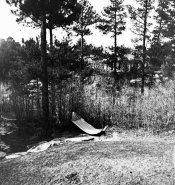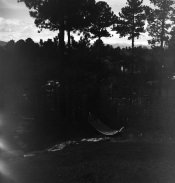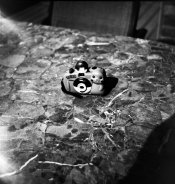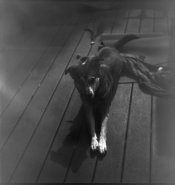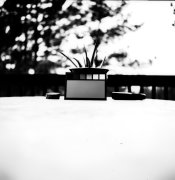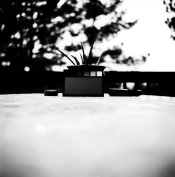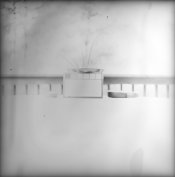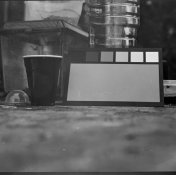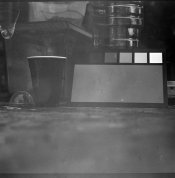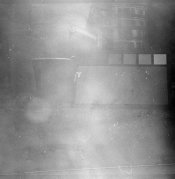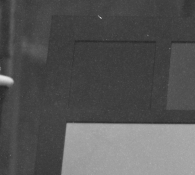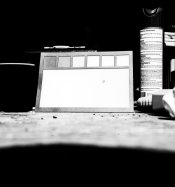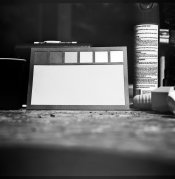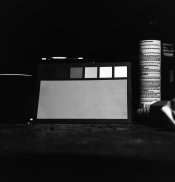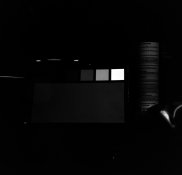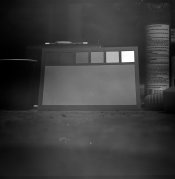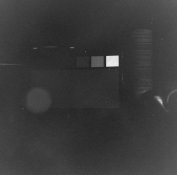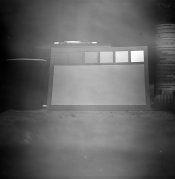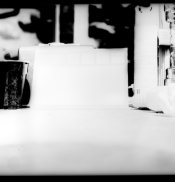grainyvision
Subscriber
I have some very slow speed 1.5 ISO Ortho Litho film (in 120 format) that I'm trying to make a bit more usable. At 1.5 ISO it looks great of course, but it's a very difficult to use speed, requiring a tripod for any depth of field even in bright daylight. I've done quite a few developer tests and the film is just that slow in the shadows. There's quite a bit of light required before the film will have any info in the shadows, but once you get over that hump it works quite well with continuous tone moderate contrast results (with careful development)
I've had as well as seen quite a bit of success with effectively increasing the speed of the film by pre-flashing. This works fine for single sheets, but it's very difficult to do with a 32" 120 sized strip of film, not to mention that it requires unrolling the film etc. The speed increase seems take this film to as high as 25 ISO or maybe even 50 ISO with higher contrast.
Apparently post-flashing is actually as effective as pre-flashing and has the same shadow speed boosting effect. I haven't tested with this film, but I've seen many reports that post-flashing is the same, as well as tested it with paper. Post flashing doesn't really make the 32" sized strip of film any easier to handle, but I had an idea. What if I used a chemical post-flash? ie, similar to the E-6 reversal bath, used something that would chemically fog the film. Would this work at all, and what kind of chemical should I use for this? I believe that chemical fogging, if I could get it perfectly even, might actually be better than light exposure. It would (in theory?) fog the shadows before the highlights with a very weak dilution reversal bath. Of course, unlike every reversal process I've seen, this is not designed to make positives, but rather just to simulate the shadow speed boosting effect of flashing, and thus would NOT be a to-completion process. The easiest to obtain reversal bath appears to be using "iron off" powdered cleaner, something like a teaspoon per roll of film and I assume around 300ml of distilled water.
Has anyone tried something like this or think it would or wouldn't work? I'm far from a chemistry expert, but I have a ton of this film that I'm trying to figure out how I can use more often. If I can do effectively a chemical post-flash that would increas speed without other ill effect it'd suddenly make these ~300 rolls worth of film I have more valuable
I've had as well as seen quite a bit of success with effectively increasing the speed of the film by pre-flashing. This works fine for single sheets, but it's very difficult to do with a 32" 120 sized strip of film, not to mention that it requires unrolling the film etc. The speed increase seems take this film to as high as 25 ISO or maybe even 50 ISO with higher contrast.
Apparently post-flashing is actually as effective as pre-flashing and has the same shadow speed boosting effect. I haven't tested with this film, but I've seen many reports that post-flashing is the same, as well as tested it with paper. Post flashing doesn't really make the 32" sized strip of film any easier to handle, but I had an idea. What if I used a chemical post-flash? ie, similar to the E-6 reversal bath, used something that would chemically fog the film. Would this work at all, and what kind of chemical should I use for this? I believe that chemical fogging, if I could get it perfectly even, might actually be better than light exposure. It would (in theory?) fog the shadows before the highlights with a very weak dilution reversal bath. Of course, unlike every reversal process I've seen, this is not designed to make positives, but rather just to simulate the shadow speed boosting effect of flashing, and thus would NOT be a to-completion process. The easiest to obtain reversal bath appears to be using "iron off" powdered cleaner, something like a teaspoon per roll of film and I assume around 300ml of distilled water.
Has anyone tried something like this or think it would or wouldn't work? I'm far from a chemistry expert, but I have a ton of this film that I'm trying to figure out how I can use more often. If I can do effectively a chemical post-flash that would increas speed without other ill effect it'd suddenly make these ~300 rolls worth of film I have more valuable









